Notice : the Performance Indices of 'Ma Lin Carbon' was updated on 20th Septembrer 2023.
1. Introduction
‘Fiber’ blades can be divided into two categories. One is ‘Outer Fiber’ blades, and the other is ‘Inner Fiber’ blades. ‘Outer Fiber’ blades are the ones with artificial fibers placed directly under top layers, which is the most external placement allowed by table tennis rule. ‘Inner Fiber’ blades are the ones with artificial fibers placed under second layers or deeper.

In fact, ‘Inner Fiber’ construction is not a good way from the viewpoint of ‘efficiency’ because it can’t fully utilize of the ability of fiber due to the reduced gap between fiber and fiber. Classic ‘Outer Fiber’ construction is much better way to improve the performance of blade. Nevertheless, ‘Inner Fiber’ construction has been frequently used for various blades from various makers. That is because ‘Inner Fiber’ construction dilutes the artificial feeling thanks to additional wood layer between top layer and fiber. We can consider it as a trade-off between performance and feeling.
Then how different is the performance of ‘Inner Fiber’ construction from that of ‘Outer Fiber’ construction? For exact comparison we need two blades whose wood layers are 100% identical but only the placement of fiber layers are different. But, I couldn’t find those blades in the market because for optimum performance ‘Inner Fiber’ blades are tuned in different way from ‘Outer Fiber’ blades due to the difference of construction. So I gave up exact comparison between ‘Inner Fiber’ and ‘Outer Fiber’. Instead, I decided to examine the performance of some known ‘Inner Fiber’ blades and some reference blades, and then to perform comparison among those blades.
2. Blades to be compared
Four ‘Inner Fiber’ blades are selected for comparison.

- Tibhar Stratus Samsonov CB (Carbon)
- Yasaka Ma Lin Carbon
- Stiga Allround Classic Carbon
- Butterfly InnerForce ZLC

Tibhar Stratus Samsonov Carbon is a representative ‘Inner Fiber’ blade from Tibhar. Although it is written as ‘CB (= Carbon)’ in its name, its fiber is not pure carbon fiber but ‘Kevlar Carbon’ which consists of carbon fiber in vertical direction and Kevlar fiber in lateral direction.

The thickness of Tibhar Stratus Samsonov CB is about 5.4mm. Top layer is Limba, and second layer is Ayous. Kevlar Carbon is placed under second layers. What is interesting is its center layer. Usually the center layer of Inner Fiber blades is Ayous. However, the center layer of Stratus Samsonov CB is Kiri which is commonly used as center layer of ‘Outer Fiber’ blades such as Butterfly Timo Boll ALC. Kiri is softer and lighter than Ayous.

Yasaka Ma Lin Carbon is carbon version of Yasaka Ma Lin series. And, it has been used by some top players. The fiber of Yasaka Ma Lin Carbon is ‘Carbon Fleece’ which is not a woven fiber but a fiber material of tissue shape. Carbon Fleece is much softer and lighter than normal ‘woven’ carbon fiber.

The thickness of Yasaka Ma Lin Carbon is about 5.5mm. Top layer is Limba, and second layer is Akazie. Carbon Fleece is placed under second layer. Center layers is Ayous which is common for Inner Fiber blades.
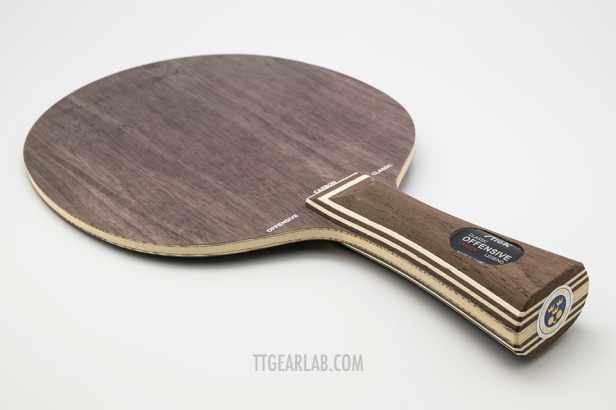
Stiga Offensive Classic Carbon is one of recent blades of Stiga. It was announced after the introduction of poly ball as carbon version of legendary Offensive Classic. As is the case of Ma Lin Carbon, its fiber material is also Carbon Fleece.

The thickness of Stiga Offensive Classic Carbon is about 5.4mm. Top layer is dyed Limba, and second layer is Tanne. Carbon Fleece is placed under second layer. Center layer is Ayous which is common for Inner Fiber blades.

Butterfly InnerForce ZLC is the top model of early InnerForce series. It is now discontinued, and instead new InnerForce Layer ZLC is being sold. The difference between old InnerForce ZLC and new InnerForce Layer ZLC is that the head size of new one is a bit reduced. Its fiber is ZL-Carbon that is also used for Mizutani Jun ZLC or Zhang Jike ZLC.
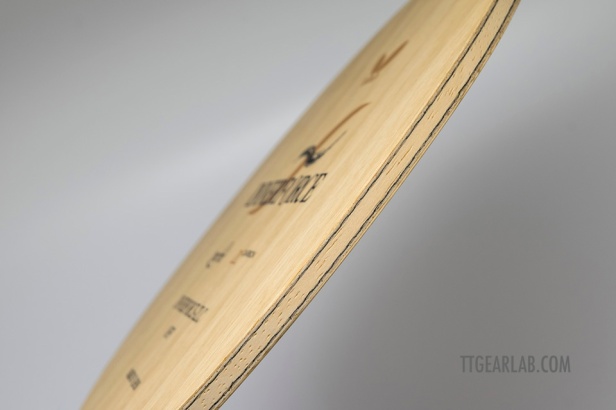
The thickness of Butterfly InnerForce ZLC is about 5.6mm. Top layer is Limba, and second layer is Ayous. ZL-Carbon is placed under second layer. Center layer is Ayous which is common for Inner Fiber blades.

For comparison, three blades with different types are selected. Three ‘reference blades’ are as follows:
- Stiga Allround Classic : 5-ply wood. Basic reference blade
- Butterfly Timo Boll ALC : Outer fiber blade. Fiber is Arylate Carbon
- Stiga Clipper CR : Thick & fast 7-ply wood blade.
Seven blades will be compared by performance indices. Concerning the detail of four performance indices, please refer to following articles in ‘Background’ section :
- Performance indices : the way to evaluate blade by measurement
- The example of comparison by performance indices
3. Comparison by Performance Indices
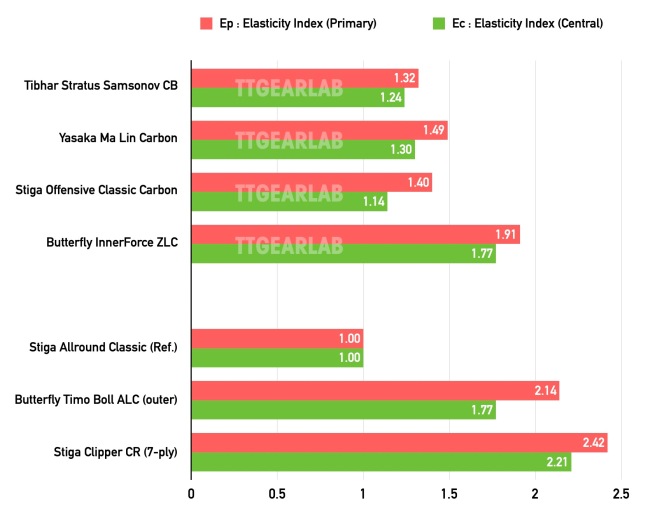
Fig.12 Comparison by Elasticity Indices
Fig.12 shows the comparison graph of Elasticity Indices
Ep is directly concerned with the rebound speed of blade. Ep of four ‘Inner Fiber’ blades are between 1.32 and 1.91. The fastest one is Butterfly InnerForce ZLC whose Ep is 1.91. And, the Ep’s of the other three are under 1.50 which is Ep of standard offensive 5-ply wood blade such as Butterfly Korbel. So we notice that the three blades except InnerForce ZLC are faster than Stiga Allround Classic but slower than standard offensive 5-ply blades. When we examine reference blades, Timo Boll ALC which is an ‘Outer Fiber’ blade is even faster than InnerForce ZLC even though its fiber material is similar to that of Tibhar Stratus Samsonov CB. (Kevlar Carbon and Arylate Carbon are not same. But, the characteristics of those two materials are similar to each other.) Also, Stiga Clipper CR which is very common and famous 7-ply wood blade is also much faster than four Inner Fiber blades.
Examining Ec/Ep is an easier way to understand the tendency of elasticity of blades. Fig.13 shows the relationship between Ec/Ep and Ep.
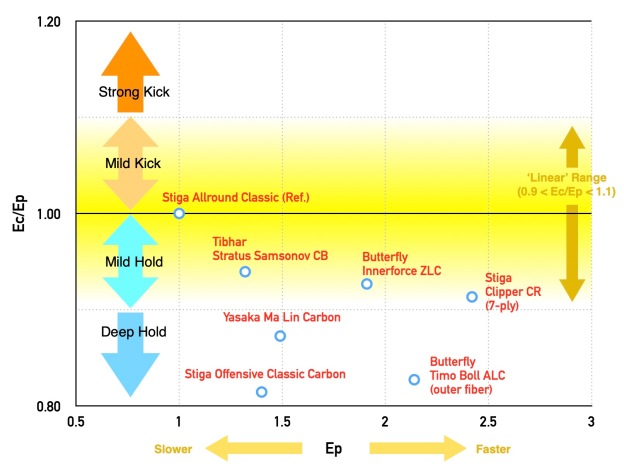
Fig.13 Ec/Ep vs. Ep
Ec/Ep expresses the ‘tendency’ of the elasticity of blade. By examining Ec/Ep and Ep at the same time, we can easily understand the behavior of blades.
As we see from Fig.12, the fastest one among four Inner Fiber blades is Butterfly InnerForce ZLC. But, it is slower than Butterfly Timo Boll ALC which is an Outer Fiber blade and Stiga Clipper CR which is a 7-ply wood blade, even though InnerForce ZLC is the blade with faster fiber – ZL-Carbon.
All Inner Fiber blades we are examining tends to hold ball when we impact ball very hard. Especially Stiga Offensive Classic Carbon shows Ec/Ep under 0.9 which can be classified as ‘Deep Hold’. It is similar tendency with Butterfly Timo Boll ALC which can also be classified as ‘Deep Hold’. The Ec/Ep’s of the other three Inner Fiber blades and Stiga Clipper CR are between 0.9 and 1.0. Those are classified as ‘Mild Hold’.
Even though Stiga Offensive Classic Carbon is much slower than Butterfly Timo Boll ALC, those two will give player similar feeling. So players can easily replace their Timo Boll ALC with Stiga Offensive Classic Carbon when they want the blade with reduced rebound and similar feeling. But, they will not be able to easily change to the other three Inner Fiber blades. Also, if players who are using Stiga Clipper CR want to replace their blade with another one with reduced rebound and similar feeling, Butterfly InnerForce ZLC can be the first consideration. And, if they want a blade with even more reduced rebound, they will be able to consider Tibhar Stratus Samsonov CB or Yasaka Ma Lin Carbon. If a player is searching for a Inner Fiber blade which is similar to Stiga Allround Classic but wants a bit increased rebound, Tibhar Stratus Samsonov CB will be the first solution, and Yasaka Ma Lin Carbon will be the second one that is considerable.
Then successively, let’s compare Vibration Indices. Fig. 14 shows the comparison graph of Vibration Indices.
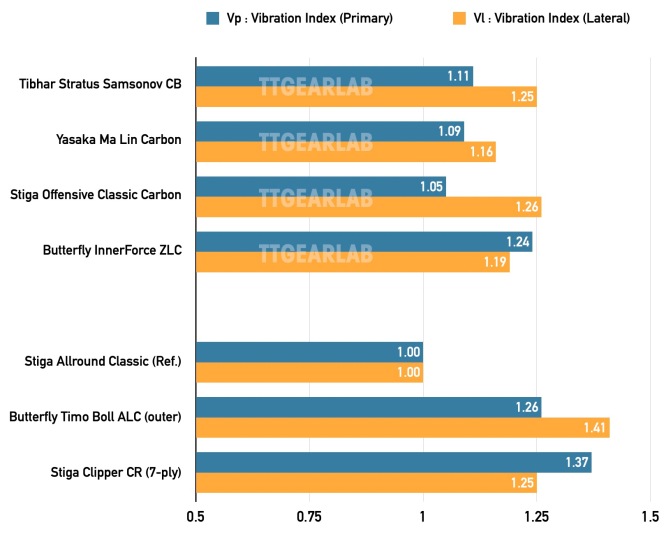
Fig.14 Comparison by Vibration Indices
Vibration Indices are concerned with feeling. Vp indicates primary feeling which is transferred to player’s palm. And, Vl is the feeling at the wing of a blade. It is felt by player’s inderx finger or middle finger.
The Vp’s of four Inner Fiber blades are widely spreaded between 1.00 (= Vp of Stiga Allround Classic) and 1.26 (= Vp of Timo Boll ALC). The hardest one is Butterfly InnerForce ZLC whose Vp is 1.24. Vp of InnerForce ZLC is very close to that of Timo Boll ZLC. The softest one is Stiga Offensive Classic Carbon whose Vp is 1.05. Vp of Offensive Classic Carbon is very close to that of Allround Classic.
Although Vp of Tibhar Stratus Samsonov CB and that of Stiga Offensive Classic Carbon are smaller than Vp of Butterfly InnerForce ZLC, those two blades show higher values of Vl than Butterfly InnerForce ZLC. It means that Stratus Samsonov Carbon and Offensive Classic Carbon feel relatively sharper at index finger. Those two blades show similar tendency as Butterfly Timo Boll Spirit. On the contrary Butterfly InnerForce ZLC shows similar tendency as Stiga Clipper CR.
Examining Vl/Vp is an easier way for the comparison of the tendency of feeling. Fig.15 shows the relationship between Vl/Vp and Vp for easier comparison.
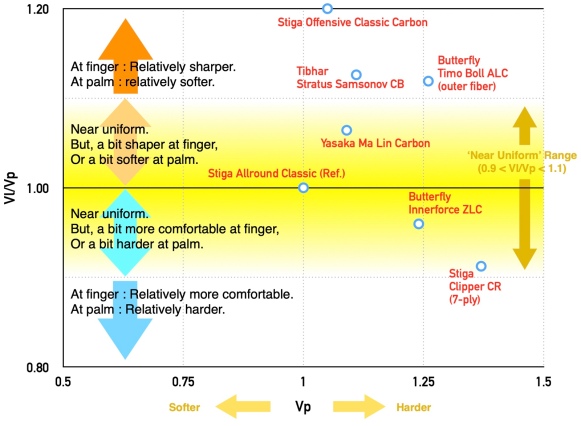
Fig.15 Vl/Vp vs. Vp
At first, as we examined above, from Fig.15 we notice that Stiga Offensive Classic Carbon and Tibhar Stratus Samsonov CB are in the same range of Vl/Vp as Butterfly Timo Boll ALC. Those three blades can be classified as ‘relatively sharper at finger’ blades. Stiga Offensive Classic Carbon showed similar result when we examine Ec/Ep vs. Ep. Stiga Offensive Classic Carbon can be slower and softer replacement of Butterfly Timo Boll ALC because it always shows similar ‘tendency’ as Timo Boll ALC. In case of Tibhar Stratus Samsonov CB, although its tendency concerning elasticity is different from that of Timo Boll ALC, it can be the soft replacement of Timo Boll ALC if player doesn’t concern elasticity but lays emphasis only on tendency of feeling.
Butterfly InnerForce ZLC, Yasaka Ma Lin Carbon can be classfied as ‘Near Uniform’ blades. (Vl/Vp is near 1.0.) But, Yasaka Ma Lin Carbon is a bit sharper at finger (or a bit softer at palm), and Butterfly InnerForce ZLC is a bit more comfortable at finger (or a bit harder at palm). As it was when we examine Elasticity Indices, Butterfly InnerForce ZLC is also classified into same category as Stiga Clipper CR when we examine Vibration Indices. And, as far as we examine Vibration Indices, Yasaka Ma Lin Carbon is very close to Stiga Allround Classic. For that reason, if player lays emphasis on the tendency of feeling, Butterfly InnerForce ZLC can be softer replacement of Stiga Clipper CR, and Yasaka Ma Lin Carbon can be harder replacement of Stiga Allround Classic. Of course if the player who is using InnerForce ZLC want faster replacement, Stiga Clipper CR will be good solution.
4. Summary
- In general, ‘Inner Fiber’ blades are slower than ‘Outer Fiber’ blades or thick 7-ply blades. But, the tendency of elasticity is not identical for all ‘Inner Fiber’ blades.
- In general, ‘Inner Fiber’ blades are softer than ‘Outer Fiber’ blades or thick 7-ply blades. But, the tendency of feeling is not identical for all ‘Inner Fiber’ blades.
- Tibhar Stratus Samsonov CB is different from Butterfly Timo Boll Spirit in the characteristics of elasticity. However, if player just concerns feeling, it can be softer replacement of Timo Boll ALC.
- Stiga Offensive Classic Carbon is much slower and softer than Butterfly Timo Boll ALC. But, it shows same tendency as Timo Boll ALC both in elasticity characteristics and vibration characteristics. For that reason it will be easy for players to move from Timo Boll ALC to Offensive Classic Carbon and vice versa even though there is difference of speed and feeling.
- Among four Inner Fiber blades compared, Butterfly InnerForce ZLC is the one that is very close to thich 7-ply wood blades such as Clipper CR. The other three are similar to 5-ply wood blades. Butterfly InnerForce ZLC will be good replacement of thick 7-ply blades, and vice versa, if players doesn’t concern the significant difference of thicknesses. (5.5mm vs. 7.0mm.)
- Tibhar Stratus Samsonov CB and Yasaka Ma Lin Carbon can be faster replacement of Stiga Allround Classic.


Unauthorized use and/or duplication of this material without express and written permission from this blog’s author and/or owner is strictly prohibited. Excerpts and links may be used, provided that full and clear credit is given to TTGear Lab with appropriate and specific direction to the original content.

Great job, real science. You understand how are deceptive the subjective impressions. Very interesting. What rubbes (hard, soft) are will be more suitable for TBS alc and Stiga OCC?
LikeLike
I think that it just differs by your personal preference. However, if you want similar feeling for those two, and you mainly feel the relationship between Vl and Vp, ‘Softer rubber + OCC’ and ‘Harder rubber + TBS’ will be good solution. In that case, TBS will be much faster and harder than OCC. But, nevertheless, changing between two combinations will be comfortable in my opinion.
My prediction may be incorrect because there are so many elements of our feeling or personal preferences. Please use my answer just as a reference.
LikeLike
And, thank you for your appreciation.
LikeLike
Thank you for the answer!
LikeLike
Very informative and useful.
LikeLike
Excellent analysis!
LikeLike
Thank you a lot for comment!
LikeLike
I am new to carbon blades . i loop heavily mid distance from the table . which blade should i choose Timo Boll ALC or innerforce ZLC ? which of these two will have higher dwell time, larger sweetspot, have more flex for looping and have good speed to control ratio ?
thanks
LikeLike
Thank you for question.
Dwell time is not concerned with blade. It differs by the kind of ball because of very unique behavior of table tennis ball. In general, it is about 1/1000s. You may ‘feel’ that the dwell time of Timo Boll ALC is longer if you tends to hit the ball. And you will ‘feel’ that the dwell time of InnerForce ZLC is longer if you just drags the ball. But, actual dwelling time is identical.
Regarding sweet spot, it is hard to compare those two blades. That is because the span between fiber and fiber is bigger in Timo Boll ALC while InnerForce ZLC has harder center layer.
By the way, I recommend you ‘InnerForce Layer ALC’ instead of those two.
LikeLike
I have a few questions for you
1) u mentioned that inner fiber blades don’t make optimum use of materials like outer fiber blades . By optimum use do u only mean the speed(rebound effect) or are there any other factors?
2) generally we know carbon blades have a larger sweetspot compared to wooden blades. Do inner fiber blades have a smaller sweetspot compared to outer fiber blades ?
3) by Ec/Ep (elasticity) do u mean flexibility ? Are inner fiber blades less flexible compared to outer fiber blades?
I appreciate your interest and work on analysing these blades
Thank you
LikeLike
Hi . I have a few questions for you.
1) you mentioned that inner fiber blades dont make optimum use of carbon compared to outer fiber blades. Is rebound speed the only factor or are there other factors when you mean optimum use?
2) Do inner fiber blades have a smaller sweetspot compared to their outer fiber counterparts?
3) are inner fiber blades less flexible compared to outer fiber blades?
Thank you
LikeLike
Thank you for reply!
(1) Yes. That is in case we think that the rebound speed is the only factor. In reality, rebound speed isn’t the everything of performance. That is the reason why inner fiber blades can exist.
(2) That is only in case all the other factors except for the placement of fiber are identical. However, in actual blades the other factors are not identical. For example, the center layer of ordinary inner fiber blades is Ayous while the center layer of ordinary outer fiber blades is Kiri. The blade with Ayous has bigger sweet spot than the blade with Kiri in case all the other factors are identical. Also there are the difference of thickness of each layer, and the difference of the kind of wood.
(3) That is also concerned with ‘other factors’ such as the kind of center wood, overall thickness, the kind of top layer wood, the thickness of each layer and the kind of middle wood. If all the other factors are identical, inner fiber blade is ‘more’ flexible than outer fiber blade.
LikeLike
This is by far the more informative article I’ve ever read on composite blades.Do you have any experience with Yasaka Extra Offensive 7 power?How does it compare with YEO ?What are the properties of Wenge compared to walnut?
LikeLike
Thank you for comment. And, I’m sorry that I don’t have Extra Offensive 7 Power. (I have some recent Yasaka blades. But, I don’t have that one.)
LikeLike
This is some real scientific insights. A deep appreciation from Vietnam
LikeLike
Thank you a lot! 🙂
LikeLike
This is very interesting analysis, and a helpful contribution to the TT community – thank you!!
Have you done any analysis on Hinoki blades? For example Joola Rossi Emotion, Andro Treiber FI or FO, or Gewo Aruna Hinoki Carbon?
It would be very interesting to see what your method reveals about the differences between Hinoki and the more commonly used outer plies Limba and Koto.
LikeLike
Thank you for comment. I have data on many Hinoki blade. However, there isn’t data for Treiber Fi/Fo and Gewo blades.
(I have the data of Treiber Z which is one of older Treiber series. But, that is different from Treiber Fi or Treiber Fo.)
Also, most of Hinoki blades have very unique construction for example ‘thick’ 3+2 ply construction. That makes the direct comparison difficult.
If all the conditions are identical and only the wood of top layer is different, blade with Hinoki surface provides lower values than the blade with another common wood for example Limba or Koto.
Following is the data of Rossi Emotion.
Ep = 1.44
Ec = 1.39 (Ec/Ep = 0.96)
Vp = 1.19
Vl = 1.19 (Vl/Vp = 1.00)
Rossi Emotion isn’t a very fast or hard blade because it is thin and its fiber is soft.
LikeLike
Thanks – that’s really interesting – I didn’t know that most Hinoki blades are 3+2 constructions rather than 5+2. I wonder why.
Two thoughts come to mind following your reply:
(1) Comparing your (objective) data with the (subjective) Revspin ratings shows that player perceptions of speed are actually pretty accurate. For example, you measure Ep of Joola Rossi Emotion, Stiga Offensive Classic Carbon and Yasaka Ma Lin Carbon as 1.44, 1.40 and 1.38 respectively. Revspin ratings in the same order are 8.7, 8.5 and 8.7 respectively. I know the YMLC should probably be about 8.5 to strictly align with your data, but it’s nevertheless notable that the three blades “cluster” around the same numbers (ie. about 1.40 and about 8.6). That suggests that, given a sufficient sample size, player perceptions about the relative speed of different blades are supported by your analysis.
(2) It would be interesting to see a comparison of innerfibre blades will all things being equal (ie. as close to equal as is possible) except the outer ply. Will your data support anecdotal wisdom about the differences between, for example, Limba, Koto, Spruce and Hinoki if you measured two of each kind? For example: Butterfly Innerforce Layer ALC and Andro Treiber CI OFF (Limba), Vodak Rebel Carbon OFF and DHS N301(Koto), Andro Ligna OFF and Donic Waldner World Champion ’89 (Spruce), Joola Rossi Emotion and Vodak Hinoki Carbon OFF (Hinoki). If you have access to such a wide range of blades it would be interesting to see what your analysis reveals about the objective differences between these outer plies.
More importantly though, your site is both fun and informative to read – keep up the excellent work!
LikeLike
In fact, there are also many Hinoki blades those are not thick. However, thick & fast 3+2 blades are more famous than moderately fast blades such as Rossi Emotion.
Currently those blades are mainly sold and used in East Asian area.
(1) It is right that you see those three models as the blades in same cluster. We have to avoid thinking about the rating too strictly because there are always errors due to various reasons.
And, in fact the analysis of Performance Indices started from the idea that expressing players’ perception by numbers. The idea of Ec or Vl are also based on players’ perception. (Of course that is no more than the start point of idea.)
(2) The comparison among products isn’t simple. What makes the comparison difficult is that the condition is not identical. Something is always different. For example the thickness of middle layer, the kind of middle layer, the thickness of center layer, the kind of center layer, the way of making the bundle of fiber, the thickness of top layer and so on.
But, anyway I will try what you suggested if I have time and chance. (In fact, I’m always trying.)
LikeLike
Thanks for the info. I did not know my Stiga Clipper CR is faster than “Inner force” carbon blades.
LikeLike
Thank you for reply. If your Clipper CR isn’t a new one whose thickness is less than 6.7mm, it is a very fast blade that is faster than most of inner ALC blades. But, if it is a new one which is thinner than old one, it is as fast as standard inner ALC blade or slower.
LikeLike
First of all, thanks for the content! i’m that I found your site, very important for us that like to learn more about our sport. If I can make a sugestion, I hope you can do comparissons in famous rubbers, like some yasaka vs butterfly, tibhars etc 🙂
But my question is: I just got a innerforce Zlc, and I know that now we just have Layer version, so if I need a new one I would not be able to get the same as my. You know the difference between them? you mentioned that the size is different, but in the game or in the feeling what would be the different? because on internet I saw some people saying that the old version is much better than the new one, and I dont know why hahah. Thank you :))
LikeLike
Can you tell us the Nittaku Acoustic Carbon inner’s data?
Thanks
LikeLike
There is data of Acoustic Carbon (Outer). However, the data of Acoustic Carbon Inner hasn’t been measured yet. I’m planning to buy the samples and update the database in near future. (Probably until the end of 2023.)
LikeLike
Ok, meanwhile can you share the data of nittaku acoustic Carbon outer?
LikeLike
Sure. Following is the data of Nittaku Acoustic Carbon :
Ep = 2.23
Ec = 1.98 (Ec/Ep = 0.88)
Vp = 1.31
Vl = 1.36 (Vl/Vp = 1.03)
LikeLike
Thanks so much TTGearLab. I came across this website and have really been enjoying reading through it.
By any chance have you any data on a 7 ply hinoki blade? There are/have been several from various manufacturers. I am curious how they measure with your methodology.
LikeLike
Thank you for comment. Currently I have two models of Hinoki 7-ply wood blades – Nittaku Septear and Yinhe Kiso Hinoki 7. The data ia as follows :
Nittaku Septear (avg.78.0g)
Ep = 1.35
Ec = 1.45 (Ec/Ep = 1.07)
Vp = 1.24
Vl = 1.21 (Vl/Vp = 0.98)
Yinhe Kiso Hinoki 7 (avg.85.3g)
Ep = 1.80
Ec = 1.82 (Ec/Ep = 1.01)
Vp = 1.30
Vl = 1.30 (Vl/Vp = 1.00)
LikeLiked by 1 person
That is great information and will help me a lot in my finding a blade to choose.
Thanks so much for your help.
LikeLike
You’re welcome. It is good that the information seems to be helpful. 🙂
LikeLike
Can you share the data of Andro Treiber Z that you have mentioned above?
LikeLike
I’m not posting the data of Treiber Z because it has already been discontinued. But, there is data.
Treber Z (avg. weight = 85.3g)
Ep = 2.20
Ec = 2.19 (Ec/Ep = 1.00)
Vp = 1.43
Vl = 1.43 (Vl/Vp = 1.00)
I hope that the data will be helpful for you.
LikeLike
Thank you
LikeLike
Thank you
LikeLike
Thank you as always TTGearLab, for the insightful information! Do you have any data for Donic original true carbon inner?
Now I begin to trust your data more than the subjective performance rating given from other sites. 🙂
LikeLike
Thank you for your appreciation. 🙂
I don’t have the data for Original True Carbon. But, I’m considering to get that blade for measurement because I’m interested in that model. Probably you’ll be able to see the result sooner or later. 🙂
LikeLike
Hi, the CLCR’s data in this blog (ep2.42) seems quite different form the one in andro Gauzy SL OFF blog:CLCR 6.5 new(ep1.46),curious about the reason.
LikeLike
The Clipper CR in this article is thicker and heavier version. Its thickness is 6.8~7.0mm, and avg. weight is 96.8g.
However, current clipper is thinner and lighter. I got the new ones after I wrote this article. The thickness of new ones is around 6.5mm, and avg. weight is 81.7g.
The differences are so significant, and we can’t deal with those two as one model.
To make it clear I will update this article.
LikeLike
I wanna ask and looking for a timo boll blade with that elasticity and vibration data. I confused with blade comparison. At first article written “Timo Boll Alc” but on explanation from fig.15 written “Timo Boll Spirit”.
Which of them is correct (Timo Boll Alc or TBS) ?
And, what letter does the serial number started with?
Best regards
LikeLike
Thank you for comment. This article is dealing with ‘Timo Boll ALC’. If it is written as ‘Timo Boll Spirit’ that is the mistake by confusion during editing this article. I will find and correct it. BTW, I don’t have the Timo Boll ALC on my hand. But, those are early models I got in 2010.
LikeLike